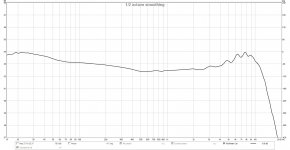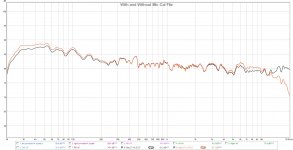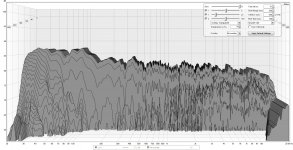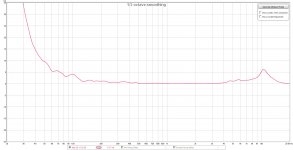There is the moving mic technique where you collect a bunch of sweeps in succession and average them. While collecting hold the mic in your hand and move it about the approximate "sweet spot" to get a good representation (on average) of where you might listen.
The moving mic would be good for EQ-ing but not such a good idea for DRC i.m.h.o.
Any sense of timing gets lost with the movement of the mic.
That mic cal sure looks like it could change some things.
Any sense of timing gets lost with the movement of the mic.
That mic cal sure looks like it could change some things.
There is the moving mic technique where you collect a bunch of sweeps in succession and average them. While collecting hold the mic in your hand and move it about the approximate "sweet spot" to get a good representation (on average) of where you might listen.
Some listening furniture guides you to sit in the same place/position more than others. With a couch, the variance could be much greater than with a stand alone chair.
I am not sure how much this matters given any system that images half way decent will have a strong center. Vocalists in particular are often located dead center. So your head ends up in pretty much the same place every time if your listening for the location of the vocalist.
With classical music, and instrumental music in general, this may not be so strait forward though.
You could apply the cal file to the corrected frequency curve from last round to check what it does to that nice straight target by clicking on the Change Cal button in the measurement...
Could be one of the reasons for the observed change in HF you heard.
Could be one of the reasons for the observed change in HF you heard.
You could apply the cal file to the corrected frequency curve from last round to check what it does to that nice straight target by clicking on the Change Cal button in the measurement...
Could be one of the reasons for the observed change in HF you heard.
Agreed.
Ill have to make sure Greg has the cal file when we do new DRC files.
OK, here are the new mdat's at 44.1
https://www.dropbox.com/s/pkkclkgzcsnau46/05%2027%2015%20REW%20MM%201M%20L%20R.mdat?dl=0
The Cal File
https://www.dropbox.com/s/w1kq9at0duicj3f/narrow_band_response_90_degree.frd?dl=0
Lets go with 3 versions, a 2 cycle, 3 cycle and 4 cycle. One of each. For Fr curve, make a strait tilt that more or less follows the mdats I am giving you (about a 9db tilt from 20-20k, or 1db/octave).
EDIT.WAIT STOP SOMETHING IS WRONG. GIVE ME A LITTLE WHILE TO FIX IT.
https://www.dropbox.com/s/pkkclkgzcsnau46/05%2027%2015%20REW%20MM%201M%20L%20R.mdat?dl=0
The Cal File
https://www.dropbox.com/s/w1kq9at0duicj3f/narrow_band_response_90_degree.frd?dl=0
Lets go with 3 versions, a 2 cycle, 3 cycle and 4 cycle. One of each. For Fr curve, make a strait tilt that more or less follows the mdats I am giving you (about a 9db tilt from 20-20k, or 1db/octave).
EDIT.WAIT STOP SOMETHING IS WRONG. GIVE ME A LITTLE WHILE TO FIX IT.
Last edited:
When I changed to 44.1, i got weird spikes. I recognized them and went to control panel and windows wouldnt let me change the mic to 44.1. Its set at 48. Redid the measurements with REW set to 48k, and the spikes are gone.
Here are the new mdats at 48k.
https://www.dropbox.com/s/o5stzhnbruzuyk9/05%2027%2015%20REW%201M%20MM%20R%20L.mdat?dl=0
The Cal File from the previous post is fine. Good luck and thanks.
Here are the new mdats at 48k.
https://www.dropbox.com/s/o5stzhnbruzuyk9/05%2027%2015%20REW%201M%20MM%20R%20L.mdat?dl=0
The Cal File from the previous post is fine. Good luck and thanks.
Last edited:
ok, 48k is fine, I'm just worried I'll forget to resample while preparing the files for DRC. I'll get to this when I can...
ok, 48k is fine, I'm just worried I'll forget to resample while preparing the files for DRC. I'll get to this when I can...
Take your time

Lets go with 3 versions, a 2 cycle, 3 cycle and 4 cycle. One of each. For Fr curve, make a strait tilt that more or less follows the mdats I am giving you (about a 9db tilt from 20-20k, or 1db/octave).
I'd include at least one correction with a Normal template (10 cycles!) just to get a glimpse on what correcting time behaviour could do. I don't expect it to sound superb, probably fake. But it might give you an idea on what's possible.
It's just one more song to listen to.

GD is based on derivative of frequency response
GD is the - derivative of the phase response with respect to frequency, -dTheta/df.
This has the correct dimensions of time.
A linear phase response, which is a constant time delay for all frequencies, gives zero GD,
since the derivative of a constant is zero.
Last edited:
GD is the - derivative of the phase response with respect to frequency, -dTheta/df.
This has the correct dimensions of time.
A linear phase response, which is a constant time delay for all frequencies, gives zero GD,
since the derivative of a constant is zero.
Thanks. That is why I have been trying to get my phase to be flatter on the FAST box. 🙂
I wanted to go back to something mentioned before. That is, looking at GD in terms of cycles instead of absolute time.
A full cycle for these frequencies is as follows:
50hz - 20ms
40hz - 25ms
30hz - 33ms
Some say 1 cycle or even 2 is inaudible. Having heard my system with 60ms, 25ms, and 15ms GD at 40hz, I can say this. 60ms to 25ms was definitely audible. 25ms to 15ms was noticeable, but barely.
Based on my listening, like many things, the idea of diminishing returns is at play. Somewhere around 2/3 or 1/2 cycle seems a good goal.
Additionally, some frequency regions are more important than others. What happens below 40hz is less important than what happens above it, IMO.
A full cycle for these frequencies is as follows:
50hz - 20ms
40hz - 25ms
30hz - 33ms
Some say 1 cycle or even 2 is inaudible. Having heard my system with 60ms, 25ms, and 15ms GD at 40hz, I can say this. 60ms to 25ms was definitely audible. 25ms to 15ms was noticeable, but barely.
Based on my listening, like many things, the idea of diminishing returns is at play. Somewhere around 2/3 or 1/2 cycle seems a good goal.
Additionally, some frequency regions are more important than others. What happens below 40hz is less important than what happens above it, IMO.
Last edited:
New files
mdat and processed tracks for 0, 2, 3, 4, and 10 cycles.
The processed tracks have the same RMS level and the "0 cycles" track should be used as the uncorrected reference since it has been level adjusted to match the others. This should make any differences between window lengths more easily heard.
https://www.dropbox.com/s/xli2nrxlqmyuhe7/2 3 4 10 cycle correction.mdat?dl=0
https://www.dropbox.com/s/kti2hv5zw2en0yy/No photo - 0 cycles.flac?dl=0
https://www.dropbox.com/s/7s6wkszukppufav/No photo - 2 cycles.flac?dl=0
https://www.dropbox.com/s/uppwc4ygp3l65s8/No photo - 3 cycles.flac?dl=0
https://www.dropbox.com/s/b46mib2qb9n1z5l/No photo - 4 cycles.flac?dl=0
https://www.dropbox.com/s/89olihhb7gah91e/No photo - 10 cycles.flac?dl=0
mdat and processed tracks for 0, 2, 3, 4, and 10 cycles.
The processed tracks have the same RMS level and the "0 cycles" track should be used as the uncorrected reference since it has been level adjusted to match the others. This should make any differences between window lengths more easily heard.
https://www.dropbox.com/s/xli2nrxlqmyuhe7/2 3 4 10 cycle correction.mdat?dl=0
https://www.dropbox.com/s/kti2hv5zw2en0yy/No photo - 0 cycles.flac?dl=0
https://www.dropbox.com/s/7s6wkszukppufav/No photo - 2 cycles.flac?dl=0
https://www.dropbox.com/s/uppwc4ygp3l65s8/No photo - 3 cycles.flac?dl=0
https://www.dropbox.com/s/b46mib2qb9n1z5l/No photo - 4 cycles.flac?dl=0
https://www.dropbox.com/s/89olihhb7gah91e/No photo - 10 cycles.flac?dl=0
- Status
- Not open for further replies.
- Home
- Loudspeakers
- Full Range
- Group Delay Questions and Analysis



